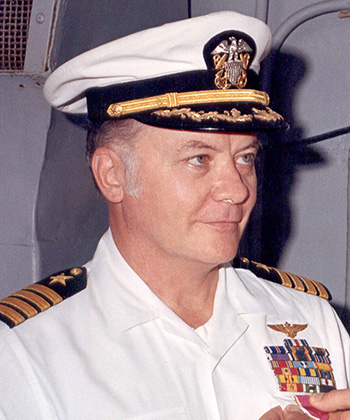
|
Wynn F. Foster |
 |
|||
| Rank, Service | ||||
Captain O-6, U.S. Navy |
||||
| Veteran of: | ||||
|
||||
| Tribute: | ||||
Wynn Foster was born on December 6, 1926, in Minnesota. He enlisted in the U.S. Naval Reserve on January 17, 1944, and began active duty with the Navy V-12A Program at Teachers College in Dickinson, North Dakota, on July 1, 1944. He attended Pre-Flight training in Iowa City, Iowa, from July to October 1945, and then flight school at Corpus Christi, Texas, from November 1945 until he was released from active duty due to the draw-down after World War II on May 8, 1946. After graduating with a bachelor's degree from the University of Minnesota, he was commissioned an Ensign and entered the U.S. Navy Flight Training Program on August 5, 1949, and was designated a Naval Aviator on December 15, 1950. Ens Foster served in Fleet Aircraft Services Squadron 7 at NAS North Island, California, from January to March 1951, and then attended Aviation Ordnance Officer School before serving as an F9F-2 Panther pilot with VF-111 at NAS Miramar, California, from May to October 1951. His next assignment was as an F9F-2 and F9F-5 pilot with VF-721 at NAS Miramar from October 1951 to March 1953, and during this time he deployed to Korea, flying 75 combat missions between July 1952 and February 1953. LtJg Foster served as an F3D-3M Skyknight Missile Test Pilot with VX-4 at NAS Point Mugu, California, from April 1953 to May 1954, followed by service as a flight instructor at NAAS Cabaniss, Texas, from June 1954 to August 1955. His next assignment was as a flight instructor at NAS Pensacola, Florida, from August 1955 to June 1957, and he then attended Line School at Monterey, California, from July 1957 to June 1958. He attended Air Control School at NAS Glynco, Georgia, from July to November 1958, and was Assistant Operations Officer aboard the aircraft carrier USS Forrestal (CVA-59) from December 1958 to September 1960. LCDR Foster next attended A-4 Skyhawk Replacement Pilot Training with VA-43 at NAS Oceana, Virginia, from November 1960 to April 1961, followed by service as an A-4 pilot, Operations Officer, and then Executive Officer of VA-76 at NAS Oceana from April 1961 to December 1962. During this time, he flew missions in support of the Cuban Missile Crisis. He served as a staff officer with the Chief of Naval Technical Training from January 1963 to September 1964, and then attended A-4 Replacement Pilot Training with VA-125 at NAS Lemoore, California, from October 1964 to January 1965. CDR Foster next served as Executive Officer of VA-163 at NAS Lemoore from January to November 1965, and then as Commanding Officer of VA-163 from November 1965 until he was badly injured during combat operations in Vietnam in July 1966. During this time, he deployed with his unit to Vietnam aboard the aircraft carrier USS Oriskany (CVA-34) from April to December 1965, and again from May to July 1966, flying 163 combat missions. During his final mission, CDR Foster lost his right arm when his aircraft was struck by enemy anti-aircraft fire, and he remained hospitalized at the Naval Hospital in Oakland, California, from August 1966 to June 1967. After being fitted with a prosthesis, he was allowed to remain on active duty, and he served with VA-125 at NAS Lemoore from June to August 1967, followed by service as a Plans and Programs Officer in the Office of the Chief of Naval Operations at the Pentagon from September 1967 to August 1968. His next assignment was as Operations Officer with the Commander, Carrier Division ONE from September 1968 to May 1970, and then as the Readiness Officer on the staff of the Commander, First Fleet from May 1970 until his retirement from the Navy on August 1, 1972. After retiring from the Navy, Wynn wrote two books, "Captain Hook: A Pilot's Tragedy and Triumph in the Vietnam War", published in 1992; and "Fire on the Hanger Deck", published in 2001. |
||||
|
||||

